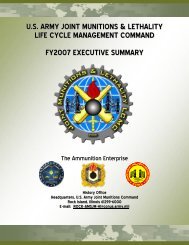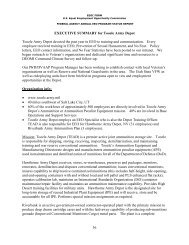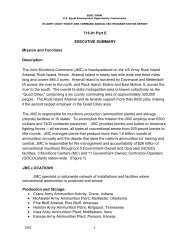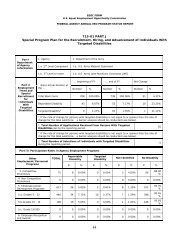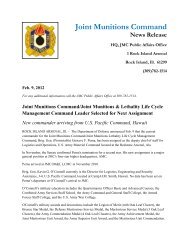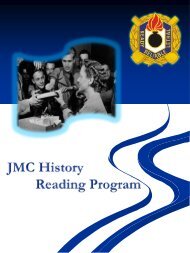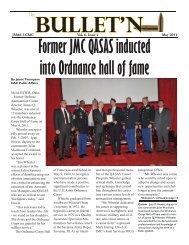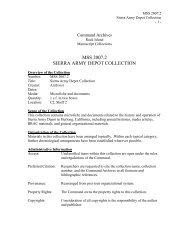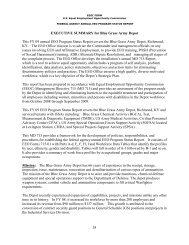History of the Ammunition Industrial Base - JMC - U.S. Army
History of the Ammunition Industrial Base - JMC - U.S. Army
History of the Ammunition Industrial Base - JMC - U.S. Army
You also want an ePaper? Increase the reach of your titles
YUMPU automatically turns print PDFs into web optimized ePapers that Google loves.
Despite shortfalls, when <strong>the</strong> threat <strong>of</strong> WWII surfaced in <strong>the</strong> summer <strong>of</strong> 1940, <strong>the</strong><br />
Ordnance Department mobilization planning created a level <strong>of</strong> readiness never before achieved<br />
in prior U.S. mobilizations. Their accomplishments included industrial requirement estimates for<br />
a major war. They created <strong>the</strong> <strong>Army</strong> <strong>Industrial</strong> College to train <strong>of</strong>ficers in <strong>the</strong> tasks <strong>of</strong> military<br />
procurement and industrial mobilization. They set up procurement districts and zones to<br />
decentralize and expedite <strong>the</strong> ga<strong>the</strong>ring <strong>of</strong> procurement information and <strong>the</strong> planning <strong>of</strong><br />
procurement operations. They arranged a systematic survey <strong>of</strong> industrial facilities and assigned<br />
those facilities to <strong>the</strong> appropriate Technical Services. They studied WWI and learned from<br />
shortages and problem areas that <strong>the</strong>y focused on to prevent repeated mistakes. They studied<br />
legislation and administrative problems that <strong>the</strong> Nation‟s resources might present in <strong>the</strong> future<br />
and created procedures to deal with <strong>the</strong>m. They also produced an <strong>Industrial</strong> Mobilization Plan, a<br />
blueprint for <strong>the</strong> control <strong>of</strong> <strong>the</strong> Nation‟s resources in time <strong>of</strong> war. 27 The initiatives and<br />
accomplishments provided invaluable administrative gains needed in <strong>the</strong> preparation for<br />
involvement in WWII.<br />
With <strong>the</strong> limited number <strong>of</strong> commercial producers, <strong>the</strong> best solution to meet future<br />
munitions requirements would be to build new government owned contractor operated (GOCO)<br />
plants for WWII. Within each passing year, <strong>the</strong> Ordnance Department (OD) directed more<br />
attention to developing plans for <strong>the</strong> speedy conversion <strong>of</strong> private industry to new munitions<br />
producers during wartime. By 1940 <strong>the</strong> American public attitude was changing, and people<br />
demanded a more adequate national defense. The U.S. had plants operating prior to U.S. entry<br />
into WWII due to <strong>the</strong> foresight <strong>of</strong> <strong>the</strong> OD and alliance needs. In 1937, <strong>the</strong> OD established joint<br />
military-commercial planning <strong>of</strong>ficers for explosives and propellants. These <strong>of</strong>fices were<br />
charged with developing plans for <strong>the</strong> construction <strong>of</strong> plants for explosive, propellants, and<br />
required chemicals. Similar <strong>of</strong>fices were established to focus on artillery, bomb, fuze, and small<br />
arms component assembly. The <strong>of</strong>fices were assisted by planners from Dupont and Hercules<br />
Powder as well as o<strong>the</strong>r experts from <strong>the</strong> limited commercial ammunition base. They considered<br />
all aspects <strong>of</strong> plant layout to include relationships with suppliers, transportation, safety distance,<br />
and line flexibility to respond to fluctuating requirements.<br />
The OD initiated <strong>the</strong>se talks because <strong>the</strong>y understood <strong>the</strong>y‟d have to create relationships<br />
between <strong>the</strong> War Department and commercial industry to produce ammunition for a global war.<br />
While o<strong>the</strong>r ordnance items and quartermaster supply requirements like trucks, airplanes, tanks,<br />
and rifles were more easily made in <strong>the</strong> commercial plants, <strong>the</strong>re were only a handful <strong>of</strong> small<br />
commercial ammunition producers. For products like smokeless powder, TNT, ammonia,<br />
artillery and small arms ammunition, <strong>the</strong>re were no existing government plants that could be<br />
readily converted. Because ammunition plants <strong>of</strong>fered none <strong>of</strong> <strong>the</strong> usual attractions for private<br />
industry and capital, <strong>the</strong> OD recognized <strong>the</strong>y would have to build at government expense.<br />
Ordnance engineers, <strong>the</strong> small peacetime explosives industry, Frankford and Picatinny Arsenals<br />
all cooperated and drew up plans and specifications for plants to be built rapidly in response to<br />
WWII.<br />
The OD was committed to building a government owned ammunition base, but realized<br />
that not all production would have to occur in GOCO plants. <strong>Base</strong>d on analysis and industry<br />
input, <strong>the</strong>y were able to limit GOCO facilities to propellant and explosive production to include<br />
required chemical manufacturing processes, while private industry made most metal parts. In<br />
27 OCH Vol. l, 5.<br />
11



